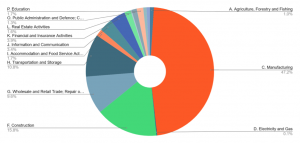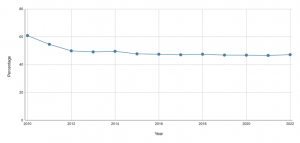By Meri Leppänen, Annika Vierinkari, Janika Sistonen, Aino Arkko, Eve Castle & Kezia Kautto
The authors are students of Global Development Studies at the University of Helsinki
Balikpapan, a city of almost 700 000 residents located on the eastern coast of Borneo has experienced remarkable changes that influenced its overall character, identity, and objectives – from its humble beginnings as a colonial outpost to a successful transformation into a thriving oil city. However, due to a need to tackle the current climate crisis and the necessity to becoming a more sustainable city, this once oil-centric city is now focusing on expanding the possibilities of a future beyond fossil fuels. The multidimensional narrative of Balikpapan, from its colonial history to the city’s rise as an oil hub, as well as its more recent attempts as a post-oil city with a focus on sustainability make Balikpapan unique. This urges us to deep dive into the city’s urban transformation and its challenges and aspirations of disposing of the oil-city status.
Colonial history – how Balikpapan was ruled and became an oil city
In the early 17th century, Balikpapan was part of the Kutai Kertanegara kingdom, which belonged to the Sultanate of Banjarmasin. After the Dutch East India Company took control of most of Kalimantan in 1817, Balikpapan became a territory of the Dutch East Indies. Kalimantan was initially seen mostly as a burden and the colonial administration imposed a no-intervention policy in the region. It was not until the discovery of a significant oil reserve in East Kalimantan that the attitude of the Dutch changed. The Dutch East Indies purchased the small fishing villages that would eventually become Balikpapan and began to be more involved in the local administration, eventually putting East Kalimantan under its authority. The drilling of oil began in 1897 by a small Dutch refinery company called Mathilda, which later attracted the Dutch oil company, Bataafsche Petroleum Maatschappij (BPM), in 1907. This led to the construction of necessary infrastructure and the arrival of skilled laborers, engineers, and managers from overseas, mainly from China and India. Consequently, many multinational companies invested in the oil industry in Balikpapan, leading to the city’s rapid economic and social growth.
The Kutai Sultanate was under a certain type of protection from the colonial government and gained income from the exploitation of oil. This became the primary way for the local aristocracy to maintain its dominance in the region. This symbiotic relationship between the sultanate and the Dutch colonial government helped create an export-oriented economy policy and increased extraction as well as uneven and unequal development within the region. Prior to the Japanese occupation of 1942-1945, frustration towards the living conditions in Balikpapan led to a nationalist movement which embraced an anti-Dutch and anti-aristocracy orientation.
Despite Indonesia’s declaration of independence in 1945, BPM continued its activities in Balikpapan until 1965, when the state-owned oil company Pertamina eventually took control of BPM’s ownership in the city after major disputes. As the only oil refinery site in the region, Balikpapan became a revitalized center of oil production. Pertamina established itsEast Borneo headquarters in the city, and other international oil companies followed suit by opening their branch offices there.
Transformation to post-oil city
Balikpapan is not a solo city that has attempted to transform into a post-oil, sustainable city. Efforts are made all around the world in oil cities, such as Abu Dhabi, Dubai and Port Hartcourt. There is clearly a pressing need for an ecological transformation in major cities, and oil cities are at the center of this. However, when talking about the changes into the post-oil era, socio-ecological issues do not always receive the attention they deserve. Developing into a sustainable city belongs to the globally shared idea that “to be green is to be modern”. The narrative of modernity and the related environmental sustainability is largely based on Western notions of sustainability and a certain image that the city gives, such as solar panel parks or green areas. However, what is meant by sustainable development often remains vague. This strategic ambiguity makes ‘sustainability’ attractive to companies and cities operating in the oil sector, for example.
Balikpapan today
At present time, Balikpapan’s economy is dominated by, and firmly reliant on, the refined petroleum and coal manufacturing industry. Employing around 13% of its working population, the manufacturing industry contributed 47.2% of the city’s gross domestic regional product (GDRP) in 2022. The city attracted many oil companies and adjacent industries. These companies brought middle to high income workers to Balikpapan and consequently increased the city’s population size, as well as diversified businesses and retail industries. Other significant industries (see figure 1) in Balikpapan also include construction (15.8% of GDRP) and transport and storage (10.8% of GDRP). The unemployment rate was at 7%, around 2% above the national average, and 2.57% of the city’s population are considered to be living in poverty (the poverty line is measured at 613, 622 rupiah per capita per month) – around 7% below the national average (see also Statistics Balikpapan, 2023d; Statistics Indonesia, 2023a; Statistics Indonesia, 2023e; Statistics Indonesia, 2023f). There also remains disparities between men’s and women’s employment, with over 50% more men working as employees compared to women.

Figure 1: Distribution of GRDP at Current Market Prices by Industry in Balikpapan (2022) (Statistics Balikpapan, 2023)
While Tarigan et al. (2017) argue that the manufacturing industry has been on a downward trend since 2010, recent data(see figure 2) shows that the GDRP has remained largely stagnant, with small fluctuating changes over the last ten years. This could suggest that manufacturing remains, and is likely to remain, an important aspect of Balikpapan’s economy. Nevertheless, structural changes in the city’s economy have been strongly influenced by oil field maturation and price fluctuation. The changes have also been affected by sustainability agendas, environmental issues and changes in political system and administration. This happened in the early 2000s, when Indonesia moved from a centralized to a decentralized political system and local governments gained more power to develop their cities and control their natural and financial resources (see also Tarigan and Sagala, 2018).

Figure 2: Distribution of GRDP at Current Market Prices for Manufacturing in Balikpapan (2010-2022) (Statistics Balikpapan, 2023a)
The city of Balikpapan is aiming to move away from depending heavily on the oil industry to becoming a more sustainable city by concentrating on five dimensions of economic development outside of oil, including services, diversified industry (e.g., renewable energy and other green industries), commerce, tourism, and education (see also Tarigan and Sagala, 2018). These changes include, for example, plans for improved public transportation, monitoring of greenhouse gas emissions, developing empty downtown areas into open green spaces for the community and creating new centers and areas concentrated in different industrial sectors (see also Tarigan et al, 2017)
Social problems resulting from urban development dominated by oil industry
There are multiple social problems that could be the characteristics of an ‘oil city’, in which urban policies have developed mainly and infrastructure in the city have been built purposely to support the one specific industry, resulting in the emerging of disadvantaged communities. To better understand today’s Balikpapan, it is important to note that during the colonization period, the central Balikpapan was designed around the oil industry and to support all the oil related facilities. Additionally, the colonial administration offices were serving as the city centre. Spatially, Balikpapan has revolved around the oil industry ever since. One of the effects of Balikpapan’s urban development is that there are areas that have been neglected. People in these areas are excluded from the basic infrastructure and the economic activities and live in poorer neighborhoods with inadequate housing around the central area. Roughly 12 sub-districts are considered as “slums”, and do not have access to clean water or proper sewer system and waste management and the housing conditions are poor. Balikpapan has just recently created plans to include farmers, fishermen, low-income households and other minority groups in the economy. Another effect is that these neglected areas could not be reached by public transportation. The city’s transportation plans failed to include the poorer communities.
The city’s workforce since the colonial era, which was over-represented by imported workers, had not necessarily improved local employment. Even though the population in Balikpapan is young nowadays, with a total of 18% of the population ranging from 25 to 39 years, and an even younger workforce growing, there are concerns about the lack of university level education, which is required for increasing local productivity and competitiveness. Despite the city’s plans to develop the accessibility and availability of education, there’s still a lack of plans to connect tertiary education with the service and other sectors, which might lead students to find opportunities outside the city or them not ending up to a job that fits their level of education.
Discussion
The neglected areas where the residents facing poor living and housing conditions and the lack of public infrastructure, the failure of providing quality and accessible public transportation, and the lack of qualified workforce in Balikpapan, as discussed, are social problems that stem from the “uneven” urban development since the colonial era which has solely facilitated the oil industry to extract natural resources and sell them. These consequences illustrate firstly that there is a certain level of city’s failure in providing basic infrastructure and a decent quality of living for all the residents, and secondly that the focus of urban development has been on the large-scale projects which benefit commercialization of the city. This being said, there’s a need for a more holistic approach that goes beyond economic progress. As characterized above, the influence of neoliberalism, which is an ideology that focuses on economic growth, is still deeply materialized in ways that has continued to undermine social sustainability, particularly in regard to urban policies and planning.
Concluding remarks
For Balikpapan, the city needs more than simply a plan to diversify their economy in order to become a more sustainable city. What is lacking is an effort to address the root causes of long-term socio-spatial inequalities and social stratification. In transitioning an oil-city to a post-oil, more sustainable city, there is a need for city managers and stakeholders to together reflect on and understand the city’s history of urban development, and to be able to make a “just” transition that does not reproduce or increase socio-spatial inequalities (see e.g. Obeng-Odoom, 2021). Besides, scholars should be critical about the idea of “I’m green, I’m modern” which is based on the confrontation between modernity and backwardness influenced by colonialism, and the spectacles of the green transition that should not be simply evaluated from the point of view of greenwashing because sustainability encompasses more than just only environmental equalitybut also social inequality (see also Koch, 2022). To fulfill its objectives of being a vibrant, inclusive, and resilient city for all its citizens, Balikpapan must recognize the historical and structural impact of its oil industry, and emphasize the needs of all inhabitants, particularly the disadvantaged, through more inclusive and participatory approach in urban policies, planning, and practices.
